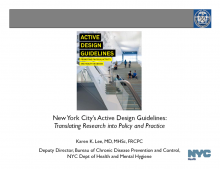We are pleased to announce an exciting new alliance between Active Living Research and GP RED to co-host and coordinate...
New York City's Active Design Guidelines: Translating Research into Policy and Practice

Presentation at the 2010 Active Living Research Annual Conference.
Download the NYC Active Design Guidelines.
Background:
Obesity and type 2 diabetes are epidemic in New York City (NYC) and are two health conditions getting rapidly worse. The majority of NYC adults and 43% of elementary school children are overweight or obese. Excessive calories (energy) are consumed through poor diet, and insufficient energy is expended through physical inactivity. Over the last few decades, physical activity has been largely designed out of our daily activities related to transportation, work and recreation. As with infectious disease epidemics of the past that have been controlled with the help of environmental changes, evidence-based design and environmental solutions need to be implemented to address chronic diseases and their risk factors, including poor diet and physical inactivity.
Objectives:
The objectives for this ALR presentation are:
1) To share the NYC strategic approach for initiating changes in the built environment to promote physical activity.
2) To share lessons learned about the process of developing the NYC Active Design Guidelines.
3) To give an overview of the Guidelines.
4) To share plans for dissemination and implementation of Guidelines.
5) To share any available evaluation results.
Methods:
The NYC Active Design Guidelines is a policy initiative to create broad built environment changes for active living in NYC. NYC’s Health Department partnered with the American Institute of Architects New York Chapter (AIANY) on joint conferences to raise awareness among architects, planners and design professionals. The Department worked with City agencies to identify projects that would link with City priorities. The Guidelines, targeted to design professionals, are a joint effort by four City agencies (including Departments of Health and Mental Hygiene, Design and Construction, City Planning and Transportation), working with academic consultants. Design practitioners’ feedback was sought through a feasibility workshop conducted on the Guidelines. The Guidelines will be used by City agencies in City building, street and neighborhood design and construction projects, and will be disseminated to private sector design professionals through design organizations such as AIANY. Evaluation includes pre-post cross-sectional surveys of AIANY architects to assess knowledge, attitudes and self-reported practices regarding physical activity promoting design factors; pre-post audits assessing incorporation of design elements that promote active living in Department of Design and Construction projects; and in-depth interviews with design teams to assess the factors influencing adoption of strategies.
Results:
The Active Design Guidelines:
• Ch. 1. Environmental Design and the Control of Epidemic Diseases: Past and Present
• Ch. 2. Urban Design - strategies for neighborhood and street design
• Ch. 3 Building Design - strategies promoting active living through stair and elevator design, and indoor/outdoor spaces for physical activity
• Ch. 4. Synergies with Environmental Sustainability and Universal Design, including the recently approved Innovation Credit for Physical Activity in Leadership in Energy and Environmental Design (LEED) green buildings certification
The Guidelines are scheduled to be published in fall 2009 and will be available in hardcopy and on City websites. As part of implementation, there are plans for trainings for public and private sector design professionals, development of incentives such as LEED innovation credits, and explorations of possible code considerations.
A baseline survey of AIANY architects has been completed with 2708 architects receiving the survey and 457 (17%) completing at least part of the survey. Respondents’ gender and race/ethnicity were comparable to AIANY membership demographics. Although the large majority of respondents report consciously incorporating design items for universal design (95%) and improved air quality (84%), only 45% report incorporating design elements for the purpose of increasing physical activity.
Conclusions:
The NYC Active Design Guidelines is a policy initiative to create broad built environment changes for active living in NYC, with participation and commitment from multiple City agencies, and incorporation of synergies with other City priorities. The Guidelines and NYC’s strategic approach may serve as models that other cities and communities can adopt. Baseline survey results suggest that there is a need for more architects to intentionally incorporate physical activity promoting design into their practice. Broad dissemination and implementation of the Guidelines are anticipated to play a critical role in increasing these practices on a large scale.
Support:
Support for evaluation is being provided by the Robert Wood Johnson Foundation’s Active Living Research Program. Support for the design practitioners’ workshop was provided by the Milbank Memorial Fund.
Related Tools & Resources
STAY UP TO DATE
RECENTLY ADDED TOOLS & RESOURCES
MOVE! A BLOG ABOUT ACTIVE LIVING
The "Active Living Conference" aims to break down research and practice silos and...







